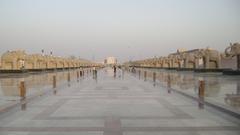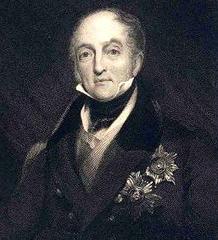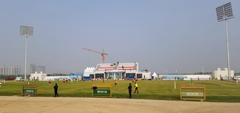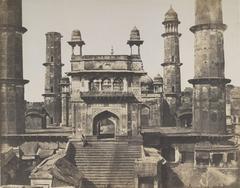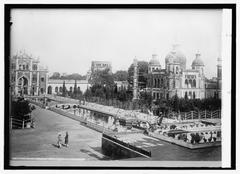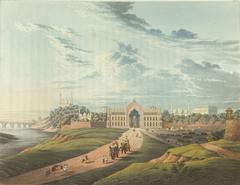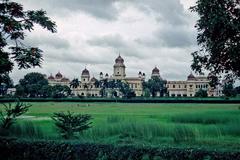
Comprehensive Guide to Visiting Lucknow, Lucknow District, India
When to Visit: 13/08/2024
Captivating Introduction
Imagine stepping into a city where the past and present coalesce in a breathtaking waltz. Welcome to Lucknow, the City of Tehzeeb and Tantalizing Tales. Picture yourself meandering through streets echoing with centuries-old stories, the aroma of succulent kebabs wafting through the air, and architectural marvels that seem to whisper secrets of bygone eras. From the grandeur of Mughal arches to the elegance of Nawabi palaces, Lucknow offers a sensory explosion that’s nothing short of a cultural fiesta (Britannica).
Lucknow’s historical canvas is painted with vibrant hues of Mughal splendor, Nawabi opulence, and British colonial intrigue. It’s a city where every brick tells a story, and every lane invites you to explore its rich heritage. Imagine walking through the Bara Imambara, a famine relief project turned architectural marvel, or standing beneath the imposing Rumi Darwaza, the Turkish Gate, feeling the pulse of history (Times of India).
But Lucknow is more than just its historical and architectural wonders. It’s a living, breathing embodiment of culture and tradition. From the lyrical cadence of its Urdu poetry to the intricate footwork of its Kathak dance, from the tantalizing flavors of its Awadhi cuisine to the delicate artistry of its Chikankari embroidery, Lucknow offers a cultural extravaganza that enchants the senses and captivates the soul (Culture and Heritage).
As you embark on this journey through Lucknow, prepare to be transported through time, guided by the city’s legends and stories. And remember, the best way to truly experience Lucknow is to explore it with Audiala, your ultimate travel companion. Download the Audiala app to uncover hidden gems, get expert insights, and make your exploration even more exciting!
Explore the Guide
- Historical Background
- Early History and Mughal Influence
- The Nawabs of Awadh
- British Colonial Rule
- The Indian Rebellion of 1857
- Post-Rebellion Era and British Governance
- Role in the Indian Independence Movement
- Architectural Heritage
- Cultural Significance
- Preservation of Traditions
- Modern-Day Lucknow
- Architectural Marvels of Lucknow
- Bara Imambara
- Chota Imambara
- Rumi Darwaza
- Jama Masjid
- The British Residency
- Husainabad Clock Tower
- Dilkusha Kothi
- La Martiniere College
- Satkhanda
- Ambedkar Memorial Park
- Gomti Riverfront Park
- Tomb of Saadat Ali Khan
- Marine Drive
- Begum Hazrat Mahal Park
- Janeshwar Mishra Park
- Hazratganj
- Aminabad
- Nawab Wajid Ali Shah Zoological Garden
- State Museum
Historical Background
Early History and Mughal Influence
Imagine a city so captivating that even Bābur, the first Mughal ruler of India, couldn’t resist its charm back in 1528. That’s Lucknow for you! Under Akbar’s reign, this gem of the Oudh province sparkled even brighter, leaving lasting imprints in architecture, culture, and administration. And oh, those Mughal arches and intricate designs? They’re not just buildings; they’re pieces of art! (Britannica).
The Nawabs of Awadh
Fast forward to 1775, and you’ll find Āṣaf al-Dawlah moving the capital from Faizabad to Lucknow. This wasn’t just a change of address; it was the start of a golden era! The Nawabs were like the rockstars of their time, turning the city into a cultural fiesta with arts, music, and literature. Ever visited the Bara Imambara or the Rumi Darwaza? These architectural wonders are the Nawabs’ way of saying, “Welcome to our grand party!” (Culture and Heritage).
British Colonial Rule
Lucknow’s story took a dramatic turn in 1856 with the British East India Company crashing the party. This sparked the Indian Rebellion of 1857, a.k.a the First War of Indian Independence. The Siege of Lucknow was a nail-biting episode where the British Residency turned into a fortress under siege (ThoughtCo).
The Indian Rebellion of 1857
The rebellion was a defining moment, with Lucknow at its heart. Both locals and nobility joined forces to give the British a tough time, turning the city into a battlefield. The ruins of the Residency and the Shaheed Smarak still echo tales of bravery and resistance (Wikipedia).
Post-Rebellion Era and British Governance
Post-rebellion, Oudh came under British governance but never lost its unique flair. By 1902, the United Provinces of Agra and Oudh emerged, blending old-world charm with new administrative structures (Wikipedia).
Role in the Indian Independence Movement
Lucknow wasn’t done making history. In 1916, it hosted the historic meeting of Mahatma Gandhi, Jawaharlal Nehru, and Mohammad Ali Jinnah, resulting in the Lucknow Pact. This city also witnessed the daring Kakori conspiracy, further igniting the independence movement (Wikipedia).
Architectural Heritage
Lucknow’s architecture is a love letter to history. Take the Bara Imambara, built in 1785 – its central hall is the largest vaulted chamber in the world without any supporting pillars. And the Rumi Darwaza? It’s inspired by Constantinople’s gateways and stands at an impressive 60 feet tall (Outlook Traveller).
The British Residency, though in ruins, is a must-visit. It’s a poignant reminder of the 1857 revolt and is now protected by the Archaeological Survey of India (Outlook Traveller).
Cultural Significance
Lucknow isn’t just a city; it’s an experience. From classical Kathak dance performances to soulful ghazals and qawwalis, this city is a cultural treasure trove. And let’s not forget the food – kebabs, biryanis, and the oh-so-delectable ‘shahi tukda’. Your taste buds are in for a treat! (Culture and Heritage).
Want to feel the city’s pulse? Head to Hazratganj or Aminabad bazaars. The hustle and bustle, the vibrant colors, and the intoxicating aromas – it’s a sensory overload in the best way possible! (Culture and Heritage).
Preservation of Traditions
Despite modernization, Lucknow holds on to its traditions. Chikan embroidery and tehzib (etiquette) are still very much alive here. These customs are not just preserved; they’re celebrated, ensuring that Lucknow remains a city deeply rooted in its historical legacy (Culture and Heritage).
Modern-Day Lucknow
Today, Lucknow is a bustling metropolis and a vital center of governance, education, and commerce. It’s part of the Uttar Pradesh Heritage Arc, a tourism initiative by the state government. With a population of 2.8 million as per the 2011 census, it’s the eleventh most populous city in India (Wikipedia).
The city is also one of the fastest-growing in India and globally, reflecting its ongoing modernization and development (Wikipedia).
In summary, Lucknow’s historical background is a rich tapestry woven with Mughal grandeur, Nawabi elegance, British colonialism, and a pivotal role in India’s independence movement. The city’s architectural marvels, cultural richness, and preserved traditions make it a fascinating destination for history enthusiasts and tourists alike. And hey, don’t forget to download the Audiala app to make your exploration even more exciting!
Architectural Marvels of Lucknow
Bara Imambara
Step into the grandeur of Bara Imambara, constructed in 1784 by Nawab Asaf-ud-Daula as a famine relief project. This iconic monument, with its central hall being the world’s largest arched hall without supporting beams, is a testament to the engineering prowess of the era. Wander through the labyrinthine Bhool Bhulaiya, and don’t miss the serene Shahi Baoli stepwell. Feel the echoes of history as you explore this architectural marvel (Times of India).
Chota Imambara
Built by Muhammad Ali Shah in the 19th century, Chota Imambara serves as a stunning congregation hall for Shia Muslims. Adorned with intricate Islamic calligraphy and Quranic verses, this monument truly comes alive during Muharram when thousands of lights illuminate its beauty. It’s more than just a sight; it’s an experience of cultural and spiritual significance (Times of India).
Rumi Darwaza
Known as the Turkish Gate, Rumi Darwaza is a 60-foot tall gateway that stands as a symbol of Nawab Asaf-ud-Daula’s benevolence. Built in 1784 during a famine, this Awadhi architectural gem is a must-see landmark. As you stand beneath its intricate arches, imagine the bustling life of the city passing through it centuries ago (eIndiaTourism).
Jama Masjid
Constructed in 1423, Jama Masjid is a unique blend of religious significance and exquisite architecture. With pillars adorned with intricate carvings inspired by Hindu and Jain cultures, this mosque offers a serene environment for worshippers and tourists alike. Open from 5 AM to 9 PM, it invites you to experience its tranquil ambiance (Times of India).
The British Residency
The British Residency, a refuge during the 1857 revolt, is now a poignant historical site. Built in the Palladian style, it houses a museum with extensive artifacts. Walk through its grounds and witness the marks of cannonballs and bullets, a stark reminder of its turbulent past. Open from 7 AM to 6 PM, it offers a journey through history (Times of India).
Husainabad Clock Tower
Standing tall at 221 feet, the Husainabad Clock Tower is a heritage structure built in 1887 to commemorate Sir George Couper’s arrival. Designed as a replica of London’s Big Ben, its intricate detailing makes it a prominent feature of Lucknow’s skyline (Times of India).
Dilkusha Kothi
Once an 18th-century English baroque-style hunting lodge, Dilkusha Kothi now lies in picturesque ruins. Offering a nostalgic peek into the opulent lifestyle of the Nawabs, the intricate designs of the palace remain a significant landmark. Despite partial destruction during the 1857 war of independence, it continues to attract visitors for its historical allure (Audiala).
La Martiniere College
Founded by Major General Claude Martin, La Martiniere College is housed in the grand Constantia building, a blend of Gothic and Palladian styles. This architectural marvel is not just an educational institution but also a reflection of Lucknow’s colonial history. The Constantia building is a must-visit for architecture enthusiasts (Times of India).
Satkhanda
Satkhanda, meaning “seven stories,” is an unfinished watchtower halted at four stories due to Nawab Muhammad Ali Shah’s death. Inspired by the Leaning Tower of Pisa, this structure blends Mughal and European styles, symbolizing the Nawab’s ambition and Lucknow’s architectural diversity (Wanderon).
Ambedkar Memorial Park
Dedicated to Dr. B.R. Ambedkar, this sprawling park features grand statues and beautiful gardens. A modern architectural marvel, it pays tribute to icons of social justice. The park offers a peaceful retreat blending natural beauty with historical significance (Audiala).
Gomti Riverfront Park
Gomti Riverfront Park, with its fountains, gardens, and walking paths, offers a serene environment along the Gomti River. This modern addition to Lucknow’s landscape provides a scenic escape from the city’s hustle and bustle, perfect for relaxation and leisure (Audiala).
Tomb of Saadat Ali Khan
The Tomb of Saadat Ali Khan is a blend of Mughal and Awadhi architectural styles, serving as a significant historical site. Visitors are advised to dress appropriately and carry headgear as a sign of respect when visiting this mausoleum (Wanderon).
Marine Drive
Lucknow’s own Marine Drive along the Gomti River is a scenic escape ideal for evening walks, jogging, or cycling. Beautifully landscaped, it offers stunning views of the river, making it a popular spot for both locals and tourists (Audiala).
Begum Hazrat Mahal Park
Dedicated to the heroine of the 1857 rebellion, Begum Hazrat Mahal Park is a peaceful retreat with lush gardens and fountains. The park is a tribute to Begum Hazrat Mahal’s bravery and offers a serene environment for relaxation and reflection (Audiala).
Janeshwar Mishra Park
Spanning 376 acres, Janeshwar Mishra Park is one of Asia’s largest parks featuring lakes, jogging tracks, and cycling paths. This modern marvel offers a blend of natural beauty and recreational facilities, making it a popular destination for families and fitness enthusiasts (Audiala).
Hazratganj
Hazratganj, the commercial heart of Lucknow, boasts traditional shops, modern cafes, and vibrant nightlife. It’s a blend of old-world charm and modern amenities, perfect for shopping and dining. Don’t miss the legendary chikan embroidery shops (Audiala).
Aminabad
Aminabad is a treasure trove of traditional Lucknowi textiles, especially chikankari work. The market is also famous for its street food, including kebabs and biryanis, offering a sensory feast for visitors. Be sure to try the iconic Tunday Kababi (Audiala).
Nawab Wajid Ali Shah Zoological Garden
Home to a diverse range of wildlife, the Nawab Wajid Ali Shah Prani Udyan, or Lucknow Zoo, features tigers, lions, and elephants. With a toy train and a museum, it’s a popular destination for families (Wanderon).
State Museum
Located within the zoo, the State Museum brims with artifacts narrating Uttar Pradesh’s rich history. It offers a comprehensive look at the region’s cultural and historical heritage (Audiala).
Conclusion: Your Next Step
Ready to explore Lucknow like never before? Download the Audiala app to uncover hidden gems, get expert insights, and make the most of your journey through this historical city. Dive into the heart of Lucknow’s architectural marvels and let history come alive with every step you take.
Cultural Significance of Lucknow
Introduction
Imagine wandering through the enchanting streets of Lucknow, where every corner breathes history and the air is perfumed with the tantalizing aroma of biryani. This city, with its seamless blend of old-world charm and modern vibrancy, is a treasure trove of cultural wonders waiting to be explored.
Historical Context
Lucknow, the capital city of Uttar Pradesh, India, is a cultural jewel shaped by the Mughals, Nawabs of Awadh, and the British. This city’s rich cultural fabric is a unique tapestry woven from these diverse influences, making it an unmissable destination for history and culture enthusiasts.
Nawabi Influence
The Nawabs of Awadh, who ruled Lucknow for over 130 years, were the maestros behind the city’s cultural renaissance. Their patronage of the arts, literature, and architecture fostered a vibrant cultural scene that still resonates today. Imagine the Nawabs’ court, a bustling hub of creativity, filled with poets, musicians, and dancers.
Call to Action
As your journey through Lucknow draws to a close, it’s clear that this city is a rich tapestry woven with threads of history, culture, and tradition. From the Mughal influences that laid its foundation to the Nawabi era that turned it into a cultural powerhouse, and the British colonial period that added layers of complexity, Lucknow stands as a testament to India’s diverse heritage (Britannica).
Lucknow’s architectural marvels, such as the Bara Imambara and Rumi Darwaza, are not just monuments but living chapters of its storied past. The city’s vibrant cultural scene, with its music, dance, literature, and cuisine, offers a sensory feast that leaves an indelible mark on the heart of every visitor (Times of India).
But what makes Lucknow truly special is its ability to blend tradition with modernity. Despite its rapid development and bustling metropolis vibe, the city has managed to preserve its age-old customs and tehzeeb (etiquette), ensuring that its heritage remains alive and celebrated (Culture and Heritage).
As you reflect on your exploration, remember that the stories and secrets of Lucknow are best experienced firsthand. So, don’t just read about it – come and immerse yourself in its enchanting charm. And to make the most of your visit, download the Audiala app. With beautifully crafted audio guides, expert insights, and hidden gems, Audiala is your perfect companion to unlock the secrets and stories of Lucknow. Embark on your adventure today and let Lucknow’s magic unfold before you!
Further Reading
- Britannica. (n.d.). Lucknow. https://www.britannica.com/place/Lucknow
- Culture and Heritage. (2024). Lucknow: The Cultural Capital of Uttar Pradesh. https://cultureandheritage.org/2024/03/lucknow-the-cultural-capital-of-uttar-pradesh.html
- Times of India. (n.d.). Finest Architectural Marvels of Lucknow. https://timesofindia.indiatimes.com/travel/destinations/finest-architectural-marvels-of-lucknow/photostory/94789808.cms


